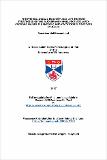Files in this item
The physiological ecology and life history strategies of the nudibranch molluscs 'Adalaria proxima' (Alder & Hancock) and 'Onchidoris muricata' (Müller) (Gastropoda: Opisthobranchia)
Item metadata
| dc.contributor.advisor | Todd, Christopher David | |
| dc.contributor.author | Havenhand, Jonathan Neil | |
| dc.coverage.spatial | 247 | en_US |
| dc.date.accessioned | 2012-06-08T15:02:11Z | |
| dc.date.available | 2012-06-08T15:02:11Z | |
| dc.date.issued | 1987 | |
| dc.identifier | uk.bl.ethos.377335 | |
| dc.identifier.uri | https://hdl.handle.net/10023/2708 | |
| dc.description.abstract | This study investigated the physiological ecology, larval biology and population genetics of the nudibranch molluscs Adalaria proxima (A & H) and Onchidoris muricata (Müller). These two species are annual, simultaneous hermaphrodites and are ecologically very similar with the exception that A. proxima reproduces by means of pelagic lecithotrophic larvae whereas Omuricata has long-term planktotrophic larvae. The aim of the study was therefore to determine the selective pressures which resulted in the evolution of different larval types in these two species, and to ascertain the ecological and population genetic consequences thereof. Simple energy budgets comprising the major components (consumption, growth, respiration and reproduction) were constructed for laboratory populations of each species. In both A. proxima and O. muricata, feeding rate displayed an asymptotic increase with body size. Mean feeding rates of A. proxima were greater than those of comparable O. muricata individuals, and overall assimilation efficiency was higher in A. proxima than in O. muricata. This difference was reflected in the somatic growth rates which were correspondingly greater in A. proxima than in O. muricata. Net growth efficiencies were broadly comparable between the two species, however, growth of A. proxima was approximately linear over' time whilst that of O. muricata displayed a curvilinear, almost exponential, pattern. This is interpreted as demonstrating that some form of constraint (possibly feeding rate) operated on the growth rates of A. proxima but not on those of O. muricata. Respiration rates were found to be relatively constant within given animals, but significant differences were found between individuals. The allometry of respiration rate was not constant; Omuricata demonstrated a more rapid increase in respiration rate with increasing body size than did A. proxima. Individual variations in respiration rate did not reflect variations in the energy partitioned to either growth or reproduction. Reproductive patterns in the two species were dissimilar. A. proxima laid fewer spawn masses containing fewer, larger ova than those laid by O. muricata individuals. In addition, the spawning period of A. proxima was shorter than that of O. muricata (60 days and 105 days respectively). Both species exhibited a similar (proportional) degree of somatic catabolism over these periods. The consequently more rapid "degrowth" of A. proxima is interpreted as the necessary utilization of an energy resource (i. e. the soma) caused by an inability to meet the energy demands of reproduction through feeding alone. This was not the case in Oanuricata individuals which exhibited a much smaller maximum body size and were able to feed at a sufficiently rapid rate to maintain reproduction. In the latter case, the longer reproductive period served to maximise the total reproductive output. Several different measures of "Reproductive Effort" (RE) were calculated. These generally indicated that the RE of Omuricata was considerably greater than that of A. proxima. Although such differences have been used in the literature to classify the respective costs of different larval types or "reproductive strategies", the variability of the RE's obtained from the different measures used here has led to the suggestion that the general lack of association between RE and reproductive strategy which has been reported elsewhere may (partially) be attributable to the different measures of RE employed in different studies. Studies of the embryonic and larval period showed that the egg-to-juvenile period of O. muricata was approximately 50% longer than that of A. proxima. This difference was primarily attributable to the extended pelagic development of O. muricata larvae. Estimates of the degree of dispersal, and hence gene-flow, between populations of these species were tested by investigating the biochemical genetics of such populations. No data were available for O. muricata, but A. proxima populations proved to be more genetically heterogeneous than had been expected. It is therefore concluded that actual pelagic dispersal may be considerably abbreviated over that expected on the basis of larval culture data alone. A model is developed to explain the possible consequences of different egg-to-juvenile periods (which accrue from different larval types) on both the ecology of the benthic adult, and on overall energy partitioning to reproduction. However, although (probable) proximate causes and effects of the different reproductive traits exhibited by A. proxima and Oanuricata are shown, it has not been possible to determine the exact selective pressures which caused A. proxima to diverge from the ancestral "O. muricata" stock through the evolution of a pelagic lecithotrophic larva. | en_US |
| dc.language.iso | en | en_US |
| dc.publisher | University of St Andrews | |
| dc.subject.lcc | QL430.5H2 | |
| dc.subject.lcsh | Gastropoda | en_US |
| dc.subject.lcsh | Snails--Juvenile literature | en_US |
| dc.subject.lcsh | Slugs (Mollusks)--Juvenile literature | en_US |
| dc.title | The physiological ecology and life history strategies of the nudibranch molluscs 'Adalaria proxima' (Alder & Hancock) and 'Onchidoris muricata' (Müller) (Gastropoda: Opisthobranchia) | en_US |
| dc.type | Thesis | en_US |
| dc.type.qualificationlevel | Doctoral | en_US |
| dc.type.qualificationname | PhD Doctor of Philosophy | en_US |
| dc.publisher.institution | The University of St Andrews | en_US |
This item appears in the following Collection(s)
Items in the St Andrews Research Repository are protected by copyright, with all rights reserved, unless otherwise indicated.

